As a bit of a corollary to my previous post about The Huntsman Effect, I decided to look into opponents’ home and away performances in 2023 for more teams. I collected data for teams from the Pac-12, SEC, Big 12, B1G, MRGC, EAGL and MAC conferences because those are the most historically successful conferences and I got sick of copy-pasting about halfway through the MAC teams.
As I mentioned in the other post, I collected home/away average data for each team then compared that to the performance against the teams in my analysis. I did not use any meets that were podium meets or away meets for every team (so no Wasatch Classic, Metroplex Challenge, etc). If a team had an away tri- or quad-meet, I used only the score for the home team in my analysis. I figured that unless there is some sort of Sharks-Jets snap battle going on to try and intimidate other teams, two teams having away meets isn’t really what I’m looking for with my analysis. This included only regular season meets, so no conference championships or regionals.
I separated my analysis into conferences because it’s a straightforward way to separate teams, and teams tend to compete against in-conference opponents more often. I created three bar plots for each conference – one for opponents’ home meets, one for away meets, and one for both home and away meets. For the home and away meet plot, I looked at away meets compared to the away average and home meets compared to the home average rather than just combining into one group.
Pac-12

Teams generally perform better than their overall average when facing Pac-12 opponents. The average increase among Pac-12 teams is 0.102. Six out of eight Pac-12 teams have positive differences, with Cal and Washington being the highest increase.


When teams come to visit a Pac-12 school, again, things go well for them, with an average of 0.134 higher than their season away average. UCLA opponents see the highest increase when they visit Pauley compared to when UCLA visits (0.297 vs -0.265). Utah, on the other hand, will make teams want to invite them rather than visit the Huntsman because the home average (-0.008) is much lower than the away average (0.315).
SEC

Competing against an SEC school is a mixed bag, with Auburn, LSU, Florida and Missouri bringing out the best in their opponents while Arkansas, Georgia, Alabama and Kentucky making teams underperform. Overall, a team competing against the SEC will average 0.026 points lower than their season average.

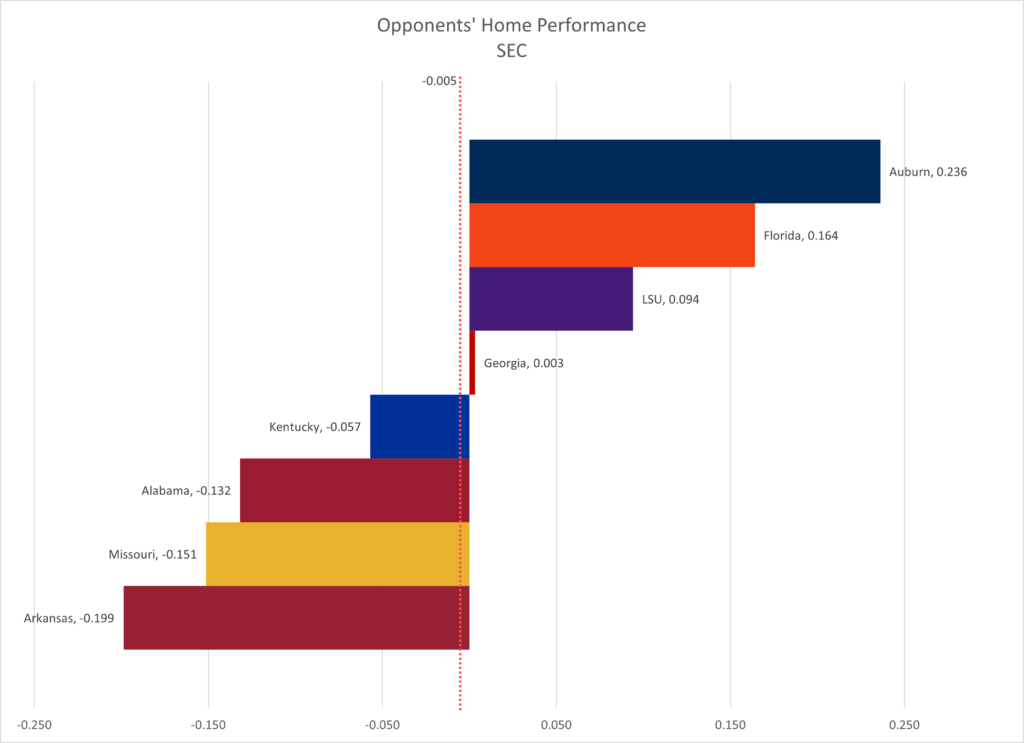
Competing against Auburn or LSU is good for opponents both at home and away, while Kentucky hosting was the scariest prospect for opponents, with them underperforming by 0.564 points compared to their average. Overall, opponents of Kentucky and Alabama saw lower-than-average scores both at home and away.
B1G

A team will fare slightly better than average when facing a random B1G team, with their overall conference average being 0.014 points higher than expected. However, the opponent makes a big difference, with Maryland boosting teams’ scores while Iowa lowering them. The B1G does get my award for the Most Consistently Decreasing Conference, with a nice, pretty, even decrease with every team. This means very little from a statistical perspective but it’s still pretty.
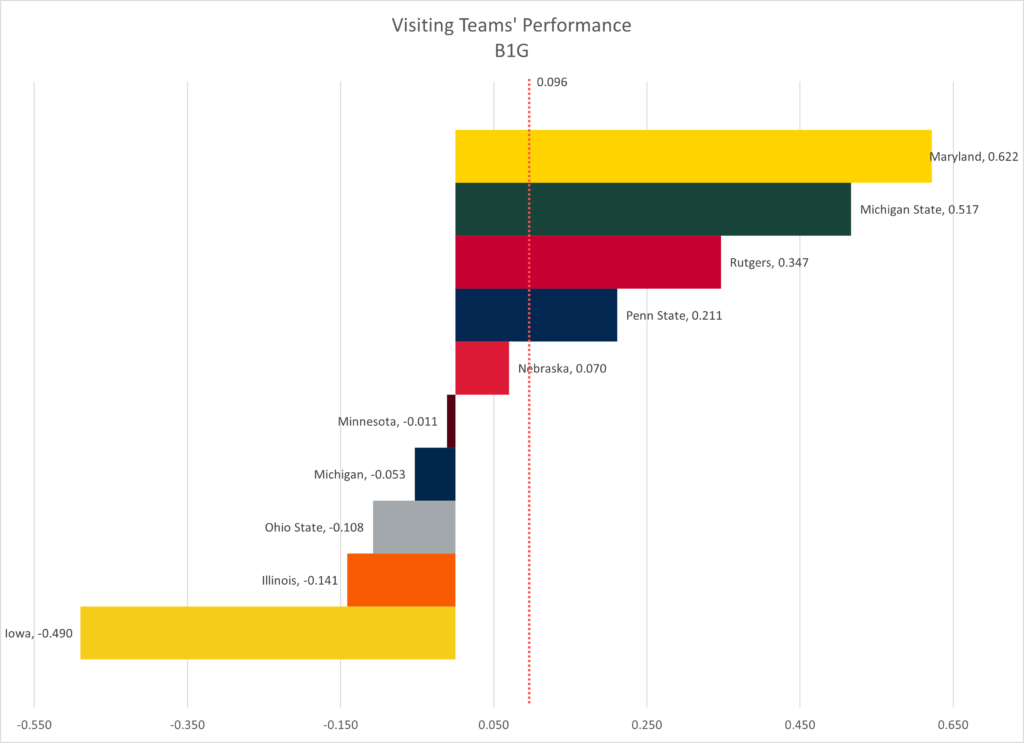
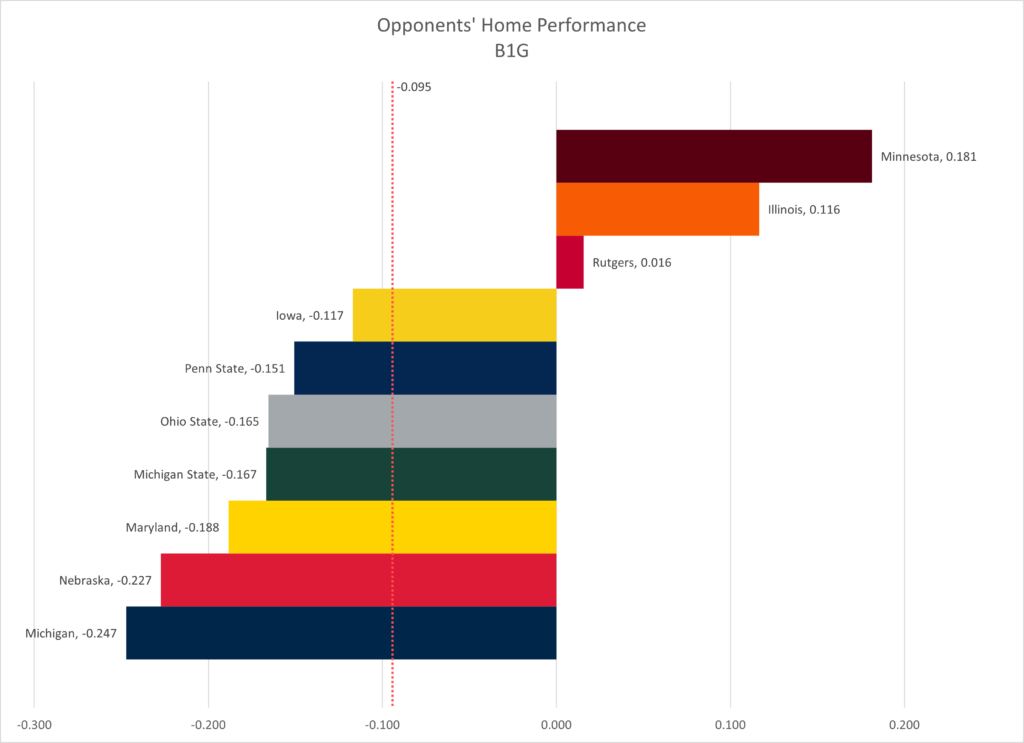
Having a B1G team come to town is bad news for scores, with seven of ten teams bringing an opponent an underperformance by more than a tenth of a point.
As for teams visit the B1G, most teams’ll be pretty good, but going to Iowa sees a decrease of 0.490 points. Maryland and Michigan State are both welcoming teams, with scores more than a half-point higher than opponents’ away averages.
Big 12

Oklahoma is the standout when it comes to Big 12 opponents’ scores. West Virginia, Iowa State and Denver all increase opponents’ scores by more than a tenth above average, but Oklahoma opponents see scores 0.043 below average.


If you’re competing against a Big 12 team, invite Denver to come visit – their opponents see 0.497 points above their average home scores. Then try to get yourself invited to Iowa State for an average score of a whopping 0.633 points above average home scores. Make sure it’s not the other way around, though, because opponents who visit Denver and Iowa State as visitors both see decreases compared to their average.
MRGC
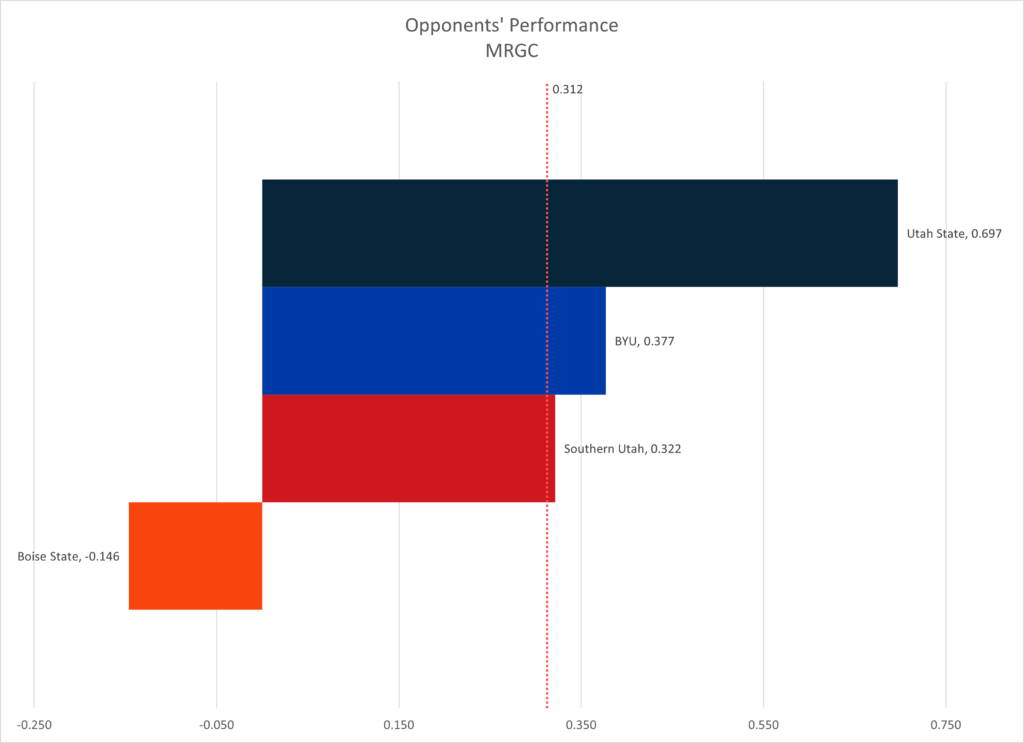
Facing one of the three Utah-based teams in the MRGC tends to be good for opponents, with BYU and Southern Utah seeing increases above three-tenths higher than their average and Utah State’s opponents seeing almost seven-tenths increases. Boise State, however, isn’t quite as accommodating, and opponents will see a decrease of 0.146 points below average.


Utah State wins my What the Heck Are You All Doing Up There award for having the highest home increase of any opponent across all conferences. Since MRGC teams face each other more than once, it looks like BYU and Southern Utah fare very well when heading up to visit Utah State. Having visited all three schools, my assumption is that the Cougars and Flippin’ Birds (yes, that really is their name, and yes, it is awesome) want to get up there and get their routines done as quickly as possible so they can get out of the cold and back home faster. But that might just be the cross-town rival trash talker in me.
EAGL

EAGL teams are positive score influences on opponents, with an average of 0.159 points increased over their season averages and seven of eight teams having positive differences. It is worth noting that EAGL teams tend to host more lower-ranked schools than the other conferences I analyzed and those teams tend to have a wider range of scores than the teams higher in the rankings. They may also benefit from having the somewhat looser scoring we see in more “prestigious” conferences when they compete against EAGL teams.
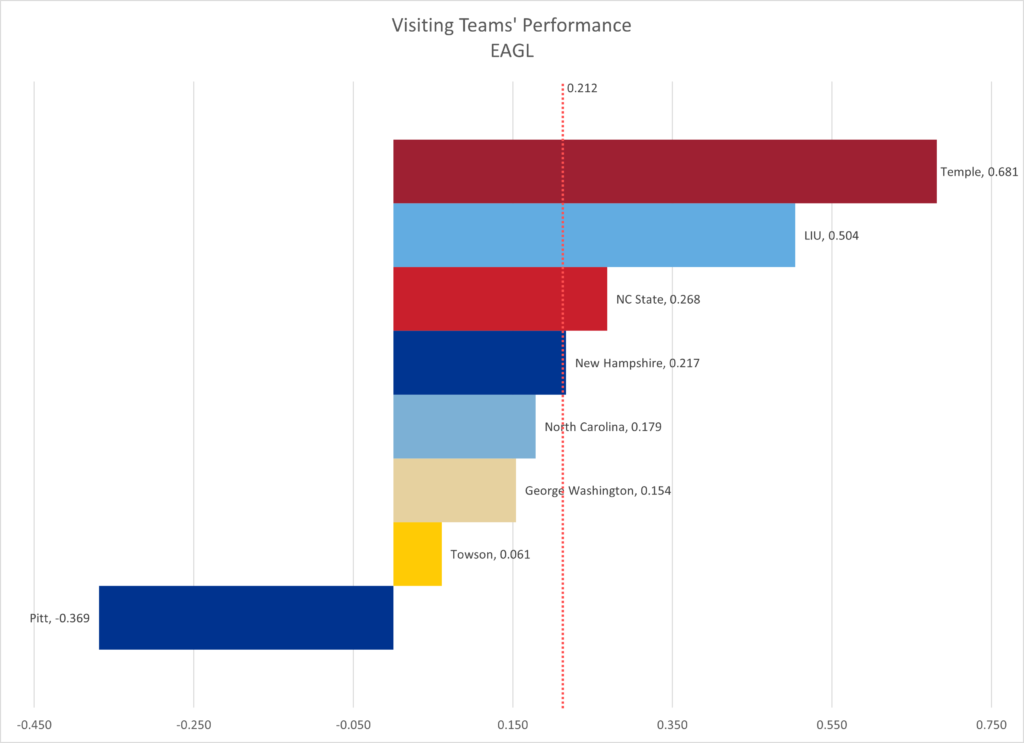

Again, we see overall averages for both home and away opponents higher than their season averages for almost all EAGL teams. The exceptions are teams visiting Pitt, who underperform their average by 0.369 points, and New Hampshire’s opponents, who underperform their home average by 0.442 points. The EAGL home average of 0.212 points above average is the highest average among every conference, home, away and combined, except the MRGC.
MAC

Teams getting in on the MACtion will see an increase of 0.061 points above their season averages when facing MAC teams, with five of seven teams’ opponents seeing above-average scores. Things in Central Michigan, however, will be middling, with averages of 0.180 below season averages (this was a terrible joke).


Things are worse than middling for Central Michigan’s home opponents, with a substantial 0.849-point decrease compared to season away averages. It is worth noting, however, that Central Michigan only had three home meets that happened in the second through fourth weeks of the season, so we can assume that there were some early-season issues that were resolved later on. Or perhaps there was some confusion since the center of Michigan is actually a Great Lake and teams brought their swimming team instead of their gymnastics team and they had to improvise (this is an even worse joke than the last one).
By Conference
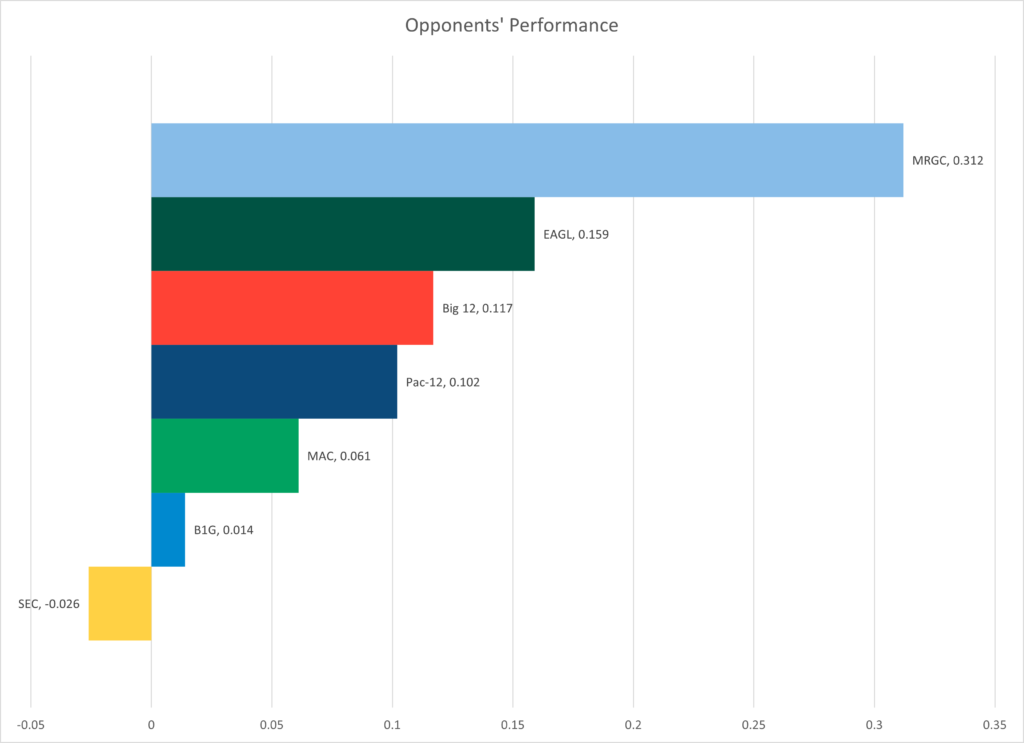
The SEC is the only major conference where opponents will see below-average scores, with a 0.026-point decrease. MRGC invites the biggest increase with 0.312 points above average (and Utah has some beautiful landscapes, so opposing teams have plenty of reasons to visit). EAGL, Big 12 and Pac-12 opponents both see an increase between one and two tenths, while MAC and B1G see an increase of less than a tenth.

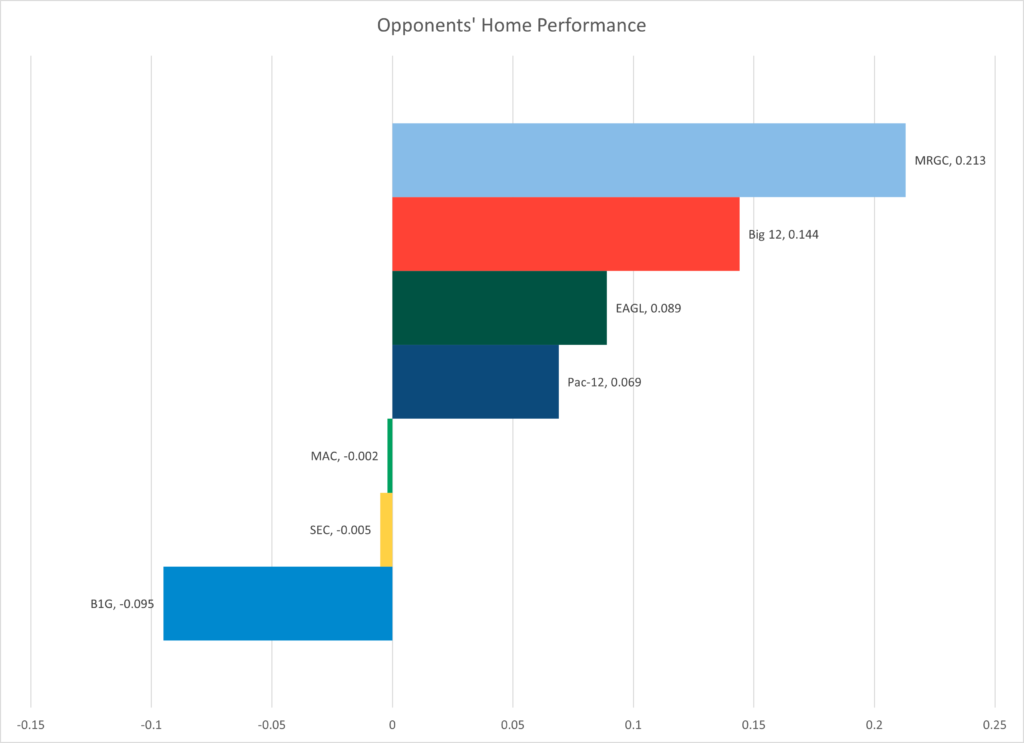
The B1G’s away performance is the biggest (hehe) outlier when comparing home and away averages, as visiting B1G teams’ opponents see a decrease of 0.095 points below their season home average.

One thought on “Rising to the Occasion”